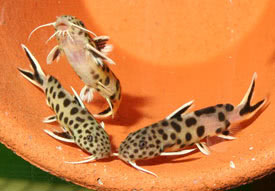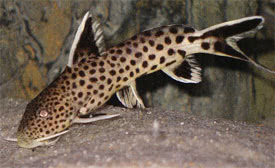
 Magyarul / Hungarian
Magyarul / Hungarian



- Scientific name : Synodontis petricola
- Common name: Even-spotted synodontis, False Cuckoo synodontis
- Group: Catfishes
- Habitat: East Africa; Lake Tanganyika
- Size: 12 cm
- Biotope: Northern part of Lake Tanganyika, above all over rocks and boulders.
- Social behavior: Quiet, peaceful species which could, however, consider fishes smaller than 4 cm as prey. It is best to associate it with larger Tanganyika cichlids or in groups.
- Diet: Omnivores, with a preference for insect larvae as food.
- Breeding: Quite easy
- Tank: Minimum 170 litres
- Population: 4-5 fish for 250 litres.
- Decoration: One corner of the tank bottom should consist of fine sand so the fish may "work" the bottom without damage to its barbels.
- Temperature: 22-26°C
- pH: 7,5-8
- Hardness: 15-30 NK°
- Lifespan: 10-15 years
Description: Synodontis petricola can be distinguishes from other synodontis species by virtue of its slender body form and the white dorsal-fin spine, and the eyes are only small. Not only the body is elongate, but the snout too is long. The caudal fin is deeply forked. The base coloration of Synodontis petricola is grey-brown or light-brown, often with an olive to copper-coloured cast, and covered with small or large dark brown to black spots. All the rayed fins are black-brown internally with white margins.
These fishes have already bred several times in captivity. They are open-spawners, and produce small, transparent sinking eggs. They can only be bred together with mouthbreeding cichlids. If the cichlids start to breed, the female will deposit some fertilized eggs in between the cichlid eggs. The cichlid male will collect it's own eggs as well as the synodontis eggs into it's mouth. The eggs of Synodontis petricola will hatch prior to the eggs of the cichlid, and the fry will start to consume the cichlid eggs, and later the newly hatched fry. At the end of the cichlids mouthbreeding period the male will release Synodontis fry instead of his own offspring. Synodontis petricola has been reported to breed with Haplochromis species, not every mouthbreeding cichlid is suitable.


